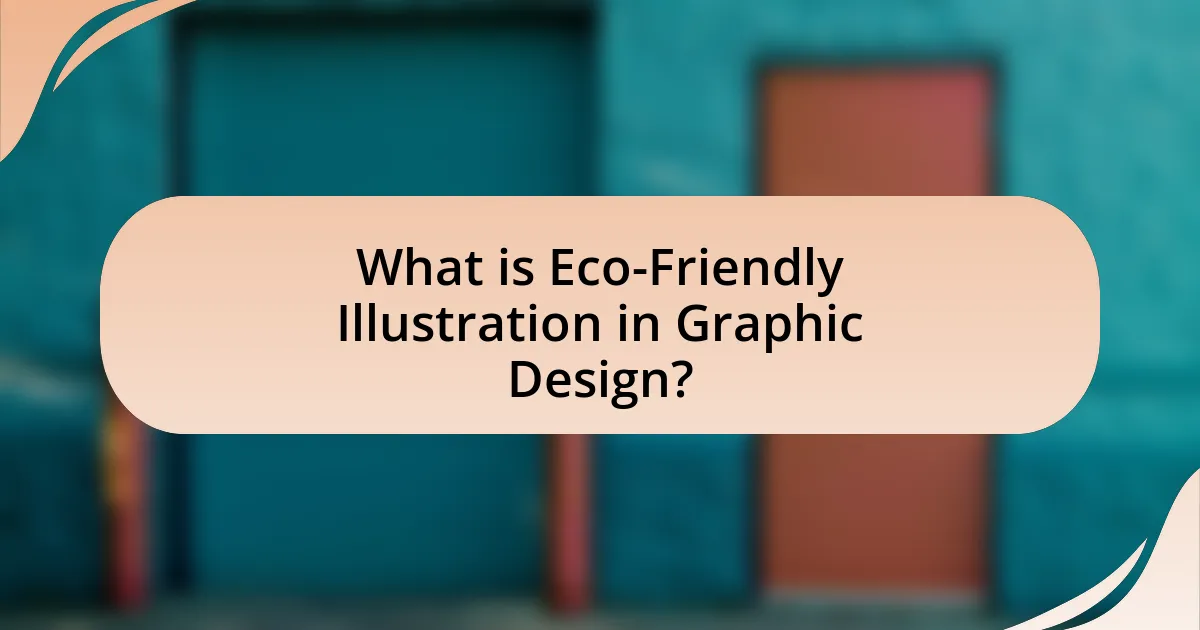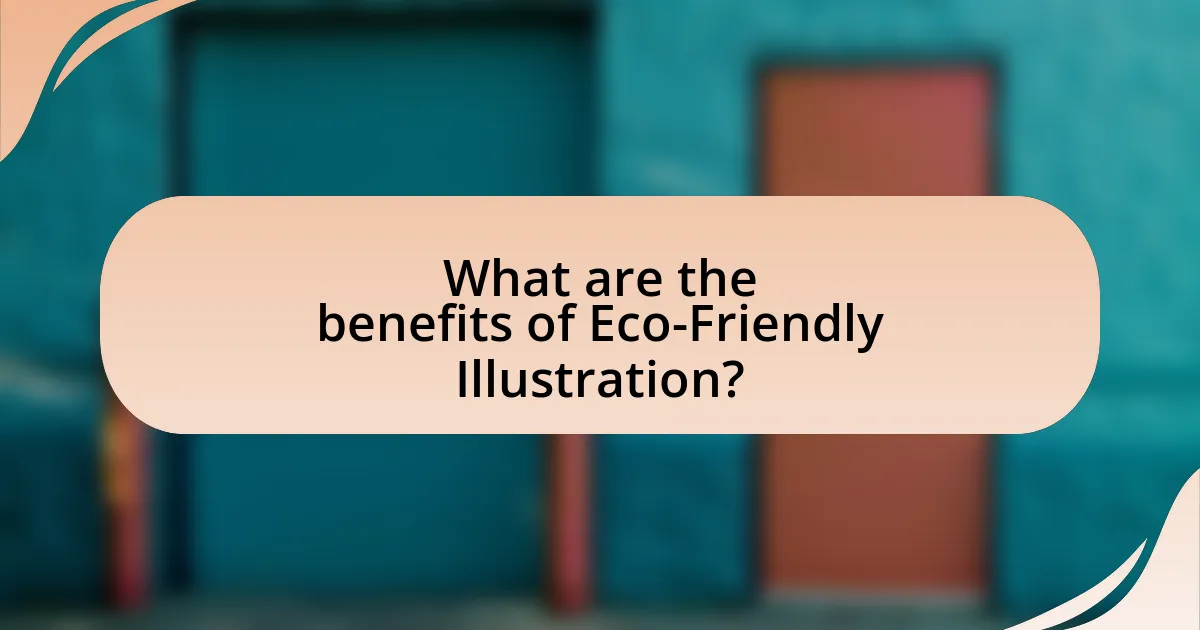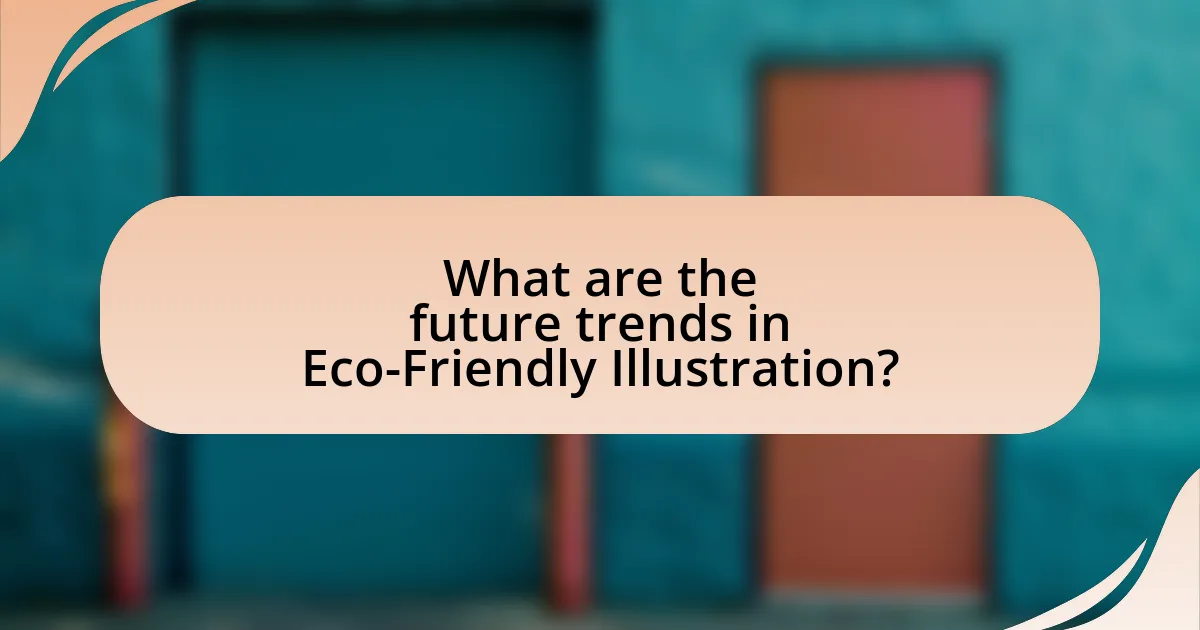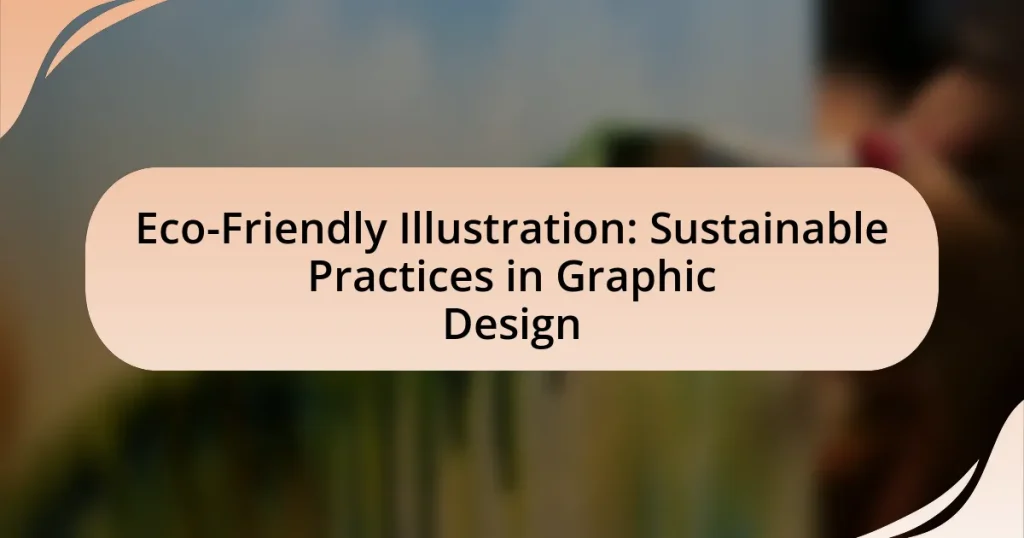Eco-Friendly Illustration in Graphic Design emphasizes sustainable methods and materials to minimize environmental impact. This article explores the differences between eco-friendly and traditional illustration, highlighting the use of recycled materials, non-toxic inks, and digital tools that reduce waste. It discusses the importance of eco-friendly practices for the environment, the challenges designers face in adopting these methods, and the economic advantages of sustainability. Additionally, the article examines consumer influence on design practices and offers practical tips for implementing eco-friendly illustration techniques. Overall, it underscores the growing demand for sustainability in the graphic design industry and the role of technology in shaping future practices.

What is Eco-Friendly Illustration in Graphic Design?
Eco-Friendly Illustration in Graphic Design refers to the practice of creating visual content using sustainable methods and materials that minimize environmental impact. This approach often involves using digital tools to reduce waste, selecting eco-friendly inks and papers, and promoting themes that raise awareness about environmental issues. Research indicates that the graphic design industry contributes significantly to waste and pollution, making eco-friendly practices essential for sustainability. By adopting these methods, designers can help reduce their carbon footprint and promote a more sustainable future in the creative field.
How does Eco-Friendly Illustration differ from traditional illustration?
Eco-Friendly Illustration differs from traditional illustration primarily in its emphasis on sustainability and environmental impact. Eco-Friendly Illustration utilizes materials and processes that minimize harm to the environment, such as using recycled paper, non-toxic inks, and digital methods that reduce waste. In contrast, traditional illustration often relies on conventional materials that may not prioritize ecological considerations, leading to higher carbon footprints and waste generation. For instance, a study by the Ellen MacArthur Foundation highlights that the fashion and textile industries, which often influence illustration practices, contribute significantly to global waste, underscoring the need for sustainable alternatives.
What materials are commonly used in Eco-Friendly Illustration?
Eco-friendly illustration commonly utilizes materials such as recycled paper, plant-based inks, and biodegradable markers. Recycled paper reduces waste and conserves resources, while plant-based inks, derived from natural sources like soy or vegetable oils, minimize environmental impact compared to petroleum-based inks. Biodegradable markers, made from non-toxic materials, ensure that the illustration process remains sustainable and reduces pollution. These materials collectively support eco-friendly practices in graphic design by promoting sustainability and reducing the carbon footprint associated with traditional illustration methods.
How do digital tools contribute to sustainable practices in illustration?
Digital tools significantly contribute to sustainable practices in illustration by reducing the need for physical materials and minimizing waste. For instance, digital illustration eliminates the consumption of paper, paints, and other traditional art supplies, which often involve resource-intensive production processes. According to a study by the University of California, digital art can reduce carbon footprints by up to 80% compared to traditional methods due to decreased material usage and transportation emissions. Additionally, digital platforms enable artists to share their work globally without the need for physical distribution, further decreasing environmental impact.
Why is Eco-Friendly Illustration important for the environment?
Eco-Friendly Illustration is important for the environment because it reduces the ecological footprint associated with traditional illustration methods. By utilizing sustainable materials, such as recycled paper and non-toxic inks, eco-friendly illustrations minimize waste and pollution. For instance, a study by the Environmental Protection Agency indicates that using recycled materials can significantly decrease the amount of waste sent to landfills, thereby conserving natural resources and reducing greenhouse gas emissions. Additionally, eco-friendly practices promote awareness and encourage consumers to make environmentally conscious choices, further contributing to sustainability efforts.
What impact does traditional graphic design have on the environment?
Traditional graphic design has a significant negative impact on the environment primarily due to the use of paper, inks, and chemicals. The production of paper contributes to deforestation, with approximately 40% of the world’s timber harvest being used for paper production, leading to habitat loss and increased carbon emissions. Additionally, traditional inks often contain harmful solvents and heavy metals, which can pollute water sources during manufacturing and disposal. The waste generated from printing processes, including excess paper and chemical runoff, further exacerbates environmental degradation.
How can Eco-Friendly Illustration reduce carbon footprints?
Eco-friendly illustration can reduce carbon footprints by utilizing sustainable materials and processes that minimize environmental impact. For instance, artists can choose digital mediums over traditional ones, which eliminates the need for paper and reduces waste. Additionally, eco-friendly illustrations often employ non-toxic inks and sustainable printing practices, which further decrease harmful emissions associated with production. Research indicates that digital illustrations can cut down carbon emissions by up to 80% compared to conventional methods, highlighting the significant potential for reducing overall carbon footprints in graphic design.
What are the key principles of Eco-Friendly Illustration?
The key principles of Eco-Friendly Illustration include sustainability, minimalism, and the use of environmentally friendly materials. Sustainability emphasizes creating designs that reduce environmental impact, such as using digital platforms to minimize waste. Minimalism focuses on simplicity, reducing unnecessary elements to lower resource consumption. The use of environmentally friendly materials involves selecting inks, papers, and processes that are non-toxic and recyclable, thereby supporting a circular economy. These principles collectively promote responsible practices in graphic design, aligning with the growing demand for eco-conscious solutions in the creative industry.
How does the choice of color affect sustainability in illustration?
The choice of color significantly affects sustainability in illustration by influencing the materials and processes used in production. For instance, using eco-friendly inks and dyes, which often have a limited color palette, can reduce environmental impact compared to traditional inks that contain harmful chemicals. Research indicates that colors derived from natural sources, such as plant-based dyes, are less toxic and biodegradable, thereby minimizing pollution. Additionally, lighter colors can require less ink during printing, leading to reduced resource consumption. Therefore, selecting sustainable colors not only enhances the ecological footprint of illustrations but also promotes responsible design practices.
What role does recycling play in Eco-Friendly Illustration practices?
Recycling plays a crucial role in Eco-Friendly Illustration practices by reducing waste and conserving resources. By utilizing recycled materials, illustrators can minimize their environmental impact, as recycled paper and inks often require less energy and water to produce compared to new materials. For instance, using recycled paper can save up to 60% of the energy needed for virgin paper production, significantly lowering carbon emissions. Additionally, incorporating recycled elements into designs promotes a circular economy, encouraging consumers to value sustainability. This practice not only supports environmental conservation but also aligns with the growing demand for eco-conscious products in the graphic design industry.
How can designers implement Eco-Friendly practices in their work?
Designers can implement eco-friendly practices by utilizing sustainable materials, reducing waste, and adopting digital tools. Sustainable materials, such as recycled paper and eco-friendly inks, minimize environmental impact during production. Reducing waste involves optimizing designs to use fewer resources and encouraging digital proofs instead of physical samples, which can significantly decrease material consumption. Additionally, adopting digital tools for design reduces the need for physical materials and allows for more efficient collaboration, further lowering the carbon footprint associated with traditional design processes. These practices are supported by the growing demand for sustainability in the design industry, as evidenced by a 2021 survey indicating that 75% of consumers prefer brands that demonstrate environmental responsibility.
What challenges do designers face when adopting Eco-Friendly Illustration?
Designers face several challenges when adopting Eco-Friendly Illustration, primarily related to material sourcing, cost implications, and consumer awareness. Sourcing sustainable materials can be difficult due to limited availability and higher prices compared to conventional options, which can deter designers from fully committing to eco-friendly practices. Additionally, the cost of eco-friendly inks and papers often exceeds that of traditional materials, impacting budget constraints for projects. Furthermore, consumer awareness and demand for eco-friendly designs can be low, making it challenging for designers to justify the transition to sustainable practices when clients may prioritize cost over environmental impact. These factors collectively hinder the widespread adoption of eco-friendly illustration in graphic design.

What are the benefits of Eco-Friendly Illustration?
Eco-friendly illustration offers several benefits, primarily reducing environmental impact and promoting sustainability. By utilizing sustainable materials and processes, eco-friendly illustrations minimize waste and pollution associated with traditional graphic design methods. For instance, using recycled paper and non-toxic inks significantly lowers carbon emissions and conserves natural resources. Additionally, eco-friendly illustrations can enhance brand reputation, as consumers increasingly prefer companies that demonstrate environmental responsibility. A study by Nielsen found that 66% of global consumers are willing to pay more for sustainable brands, indicating a market advantage for businesses adopting eco-friendly practices.
How does Eco-Friendly Illustration enhance brand image?
Eco-Friendly Illustration enhances brand image by aligning a company’s visual identity with sustainable values, thereby attracting environmentally conscious consumers. This alignment fosters trust and loyalty, as 66% of global consumers are willing to pay more for sustainable brands, according to a Nielsen report. By utilizing eco-friendly practices in illustration, brands not only demonstrate their commitment to sustainability but also differentiate themselves in a competitive market, ultimately leading to a positive perception and increased customer engagement.
What examples exist of brands successfully using Eco-Friendly Illustration?
Brands such as Coca-Cola, Starbucks, and Unilever have successfully utilized eco-friendly illustration in their marketing strategies. Coca-Cola’s “World Without Waste” campaign features illustrations that emphasize recycling and sustainability, effectively communicating their commitment to reducing plastic waste. Starbucks employs eco-friendly illustrations in their packaging and promotional materials to highlight their sustainable sourcing practices, such as using recycled materials and promoting plant-based options. Unilever’s “Sustainable Living” initiative incorporates illustrations that depict their efforts in reducing environmental impact, showcasing products that are made with sustainable ingredients. These examples demonstrate how brands can leverage eco-friendly illustration to enhance their sustainability messaging and engage consumers.
How can Eco-Friendly practices attract environmentally conscious consumers?
Eco-friendly practices attract environmentally conscious consumers by aligning brand values with their commitment to sustainability. When businesses adopt eco-friendly methods, such as using sustainable materials or reducing waste, they signal to consumers that they prioritize environmental responsibility. Research indicates that 66% of global consumers are willing to pay more for sustainable brands, highlighting the demand for eco-conscious products. Furthermore, brands that transparently communicate their eco-friendly initiatives can build trust and loyalty among consumers, as evidenced by a Nielsen report showing that 73% of millennials are willing to pay extra for sustainable offerings.
What economic advantages does Eco-Friendly Illustration offer?
Eco-Friendly Illustration offers significant economic advantages by reducing production costs and attracting a growing market of environmentally conscious consumers. By utilizing sustainable materials and processes, businesses can lower expenses associated with waste disposal and resource consumption. For instance, companies that adopt eco-friendly practices often benefit from tax incentives and grants aimed at promoting sustainability, which can further enhance their financial performance. Additionally, research indicates that 66% of global consumers are willing to pay more for sustainable brands, demonstrating that eco-friendly illustrations can lead to increased sales and customer loyalty.
How can cost savings be achieved through sustainable practices?
Cost savings can be achieved through sustainable practices by reducing resource consumption and minimizing waste. For instance, using digital tools instead of traditional materials in graphic design decreases costs associated with printing and physical supplies. Additionally, sustainable practices such as optimizing energy use in production can lead to lower utility bills. A study by the Carbon Trust found that companies implementing energy-efficient measures can save up to 20% on energy costs. Furthermore, utilizing recycled materials can lower procurement costs while also appealing to environmentally conscious consumers, potentially increasing sales.
What funding opportunities exist for Eco-Friendly design projects?
Funding opportunities for eco-friendly design projects include grants from government agencies, non-profit organizations, and private foundations focused on sustainability. For instance, the Environmental Protection Agency (EPA) offers grants for projects that promote environmental education and sustainable practices. Additionally, organizations like the Sustainable Arts Foundation provide funding specifically for artists and designers working on eco-friendly initiatives. The National Endowment for the Arts also supports projects that incorporate sustainability into their design processes. These funding sources are aimed at fostering innovation in eco-friendly design and encouraging the adoption of sustainable practices in graphic design.

What are the future trends in Eco-Friendly Illustration?
Future trends in eco-friendly illustration include the increased use of digital tools to reduce waste, a focus on sustainable materials for physical illustrations, and the integration of environmental themes into artwork. Digital illustration minimizes the need for paper and traditional materials, aligning with sustainability goals. Additionally, artists are increasingly opting for eco-friendly inks and recycled materials, reflecting a commitment to reducing their carbon footprint. Research indicates that the global market for sustainable graphic design is projected to grow significantly, driven by consumer demand for environmentally responsible practices. This trend is supported by a growing awareness of climate change and the importance of sustainability in creative industries.
How is technology shaping the future of Eco-Friendly Illustration?
Technology is shaping the future of eco-friendly illustration by enabling digital tools that reduce waste and promote sustainable practices. Digital illustration software, such as Adobe Illustrator and Procreate, allows artists to create without the need for physical materials, significantly decreasing paper and ink consumption. Additionally, advancements in 3D printing technology enable the production of eco-friendly materials, allowing illustrators to create tangible products with a lower environmental impact. Furthermore, online platforms facilitate the sharing of eco-conscious design resources and communities, fostering collaboration among artists committed to sustainability. These technological innovations collectively contribute to a more sustainable approach in the field of illustration.
What innovations are emerging in sustainable materials for illustration?
Innovations in sustainable materials for illustration include the development of biodegradable inks, recycled paper, and plant-based materials. Biodegradable inks, made from natural pigments and oils, reduce environmental impact compared to traditional petroleum-based inks. Recycled paper, which utilizes post-consumer waste, minimizes deforestation and energy consumption in production. Additionally, plant-based materials, such as those derived from algae or agricultural byproducts, are being explored for their potential to replace conventional materials, offering a lower carbon footprint. These advancements reflect a growing commitment within the graphic design industry to adopt eco-friendly practices and materials.
How can artificial intelligence contribute to Eco-Friendly design practices?
Artificial intelligence can significantly enhance eco-friendly design practices by optimizing resource usage and minimizing waste. AI algorithms can analyze vast amounts of data to identify sustainable materials and processes, leading to more efficient design solutions. For instance, AI-driven tools can simulate various design scenarios, allowing designers to select options that reduce environmental impact, such as energy consumption and material waste. Research from the Journal of Cleaner Production indicates that AI applications in design can lead to a reduction of up to 30% in material waste by optimizing production processes. This demonstrates that integrating AI into design practices not only fosters sustainability but also promotes economic efficiency.
What role do consumers play in promoting Eco-Friendly Illustration?
Consumers play a crucial role in promoting Eco-Friendly Illustration by driving demand for sustainable design practices. Their purchasing choices influence companies to adopt environmentally responsible methods, such as using recycled materials and eco-friendly inks. Research indicates that 66% of global consumers are willing to pay more for sustainable brands, highlighting the significant impact of consumer preferences on market trends. This demand encourages illustrators and graphic designers to prioritize eco-friendly techniques, thereby fostering a culture of sustainability within the industry.
How can consumer demand influence design practices?
Consumer demand significantly influences design practices by driving designers to prioritize sustainability and eco-friendly materials. As consumers increasingly seek environmentally responsible products, designers adapt their practices to incorporate sustainable materials, reduce waste, and create designs that resonate with eco-conscious values. For instance, a 2021 survey by Nielsen found that 73% of global consumers are willing to change their consumption habits to reduce environmental impact, prompting designers to innovate in ways that align with these preferences. This shift not only enhances brand loyalty but also encourages the adoption of sustainable practices across the industry, demonstrating the direct correlation between consumer demand and design evolution.
What actions can consumers take to support Eco-Friendly designers?
Consumers can support eco-friendly designers by choosing to purchase products made from sustainable materials and supporting brands that prioritize environmentally friendly practices. By selecting items that are crafted from organic, recycled, or upcycled materials, consumers directly contribute to reducing waste and resource consumption. Additionally, consumers can research and buy from companies that implement ethical production processes, such as fair labor practices and minimal carbon footprints. Supporting local eco-friendly designers also reduces transportation emissions, further enhancing sustainability. According to a 2021 survey by Nielsen, 73% of global consumers are willing to change their consumption habits to reduce environmental impact, highlighting the growing demand for eco-conscious products.
What are some practical tips for adopting Eco-Friendly Illustration practices?
To adopt eco-friendly illustration practices, artists should prioritize digital tools over traditional materials, as digital illustration significantly reduces waste and resource consumption. Utilizing software like Adobe Illustrator or Procreate minimizes the need for paper, paints, and other physical supplies, which can contribute to environmental degradation. Additionally, artists can choose sustainable materials when physical illustration is necessary, such as recycled paper and non-toxic inks, which are less harmful to the environment. Research indicates that using eco-friendly materials can reduce carbon footprints by up to 30% in the production process. Furthermore, artists should consider local sourcing for materials to decrease transportation emissions and support local economies. By implementing these strategies, illustrators can effectively contribute to sustainability in their work.


